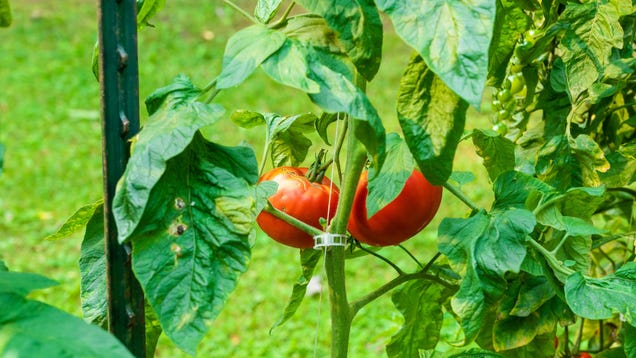Here we are in July, where most of us are staring down the tomatoes in our garden, trying to will them to turn red (or orange, yellow, or purple). This is also a critical time for ensuring the health of your tomatoes by making sure those vines are well-supported with a sturdy trellis technique.
The difference between indeterminate and determinate tomatoes
There are two kinds of tomatoes: indeterminate and determinate. Your seeds or starts came with a tag that told you which type your tomatoes are, and it’s important for trellising. Your indeterminate tomatoes will set flowers and fruit over the whole season, and those vines tend to grow much taller, prompted by this ongoing growth cycle and the pruning you might be doing. They’ll need more support vertically.
Your determinate tomatoes set flowers just once or twice a season, resulting in a lot of fruit all at once. They require more trellising horizontally, as they tend to be bushier.
Why you shouldn’t use a traditional tomato cage
We all know the traditional tomato cage, made up of some cheap metal stakes held together in a tornado shape. Most people use these correctly, or upside down: The smallest part of the tornado should go in the ground. But these cages are also only 30-48-inches tall, and that’s simply not enough for most tomatoes. Indeterminates can easily grow six feet or taller, and determinants, when healthy, will also eclipse the height of most cages.
They also don’t provide enough support—on a determinate plant, you require more support for branches farther away from the main stem. For this reason, they’re not the best choice. This is also the reason I think single stakes aren’t ideal—they don’t support your branches off the main stem, which is critical.
Try trellising your tomatoes overhead
By trailing string from an overhead support, you can clip your tomato plants to the string using small plastic clips. The clips catch the string, and then loosely hold the tomato vine, allowing it room to grow, while holding it vertically. You can drop as many strings as you need to support one plant, although it’s ideal to keep indeterminates to just a few vines (called leaders).
The easiest way to do this is by creating a simple structure from 2-x-4s. Attach vertical 2-x-4s to your gardening bed with at least two screws on each side so they don’t wobble, with a 2-x-4 that connects them across the top. Then simply drape the string over the 2-x-4 at the top.
You’ll trellis over the course of the whole season, every other week or so, attaching new clips. At the end of the season, you collect the clips and disinfect them, and they can be used again.
There are commercial systems that work similarly, like the new Freyr trellis, which a number of gardeners I respect have purchased and raved about.
Use the ‘Florida weave’ method to trellis your tomatoes
When you have many determinants in a row, the Florida weave is a fast, easy, and inexpensive way to support your plants. You only need a vertical support like a metal stake at the end of your rows. You tie your string to the stake, and then weave it back and forth around every other plant, going up the row, and then tie it to the metal stake at the end of the row. You usually do this every 18 inches or so. It creates a support system, and is super fast.
Make a trellis from cattle panels and rebar mesh
There are few things are spectacular as indeterminate tomatoes trellising up and over a garden arch, with tomatoes drooping down like grapes. For cherry tomatoes in particular, this is a great way to use an arch in summer—as long as you have indeterminates. To make such an arch, you can purchase commercial arches, which are popular right now, or make your own using a cattle panel. These sixteen-foot-long steel mesh grids are exactly what they say they are: for herding cattle. But they have just enough flex to be used all over the country for garden arches, too. You’ll find them at farm stores like Wilco.
You can use the same cattle panels or rebar mesh, which is more easily found at outlets like Home Depot, to build a vertical or horizontal trellis. Place metal stakes at either end of the panel, and ziptie the cattle panel to it horizontally. As your tomatoes grow, you will use garden twine, garden velcro or tomato clips to splay the tomato against the panel, giving it support.
Rebar mesh is just seven feet by four feet, so its much more manageable and the perfect height for a vertical or horizontal trellis used in the same way as above. The most interesting idea I’ve seen recently is from Meg Cowden of Seed to Fork, who uses the steel supports to mount the mesh parallel to the ground, rather than perpendicular. She uses two of them vertically, and the tomatoes grow up and through the grid, offering support. This is ideal for determinants that need to spread out, not up.
Trellising isn’t just about support. It gives you a way to create airflow around your plant, which means less disease and better access for pollinators. It keeps the plant and fruit off the ground, which means less disease but also less infiltration from ground pests eating your tomatoes.

Leave a Reply
You must be logged in to post a comment.